Conservation Grassland Awards
Flying u Cattle, 2023
Arthur County
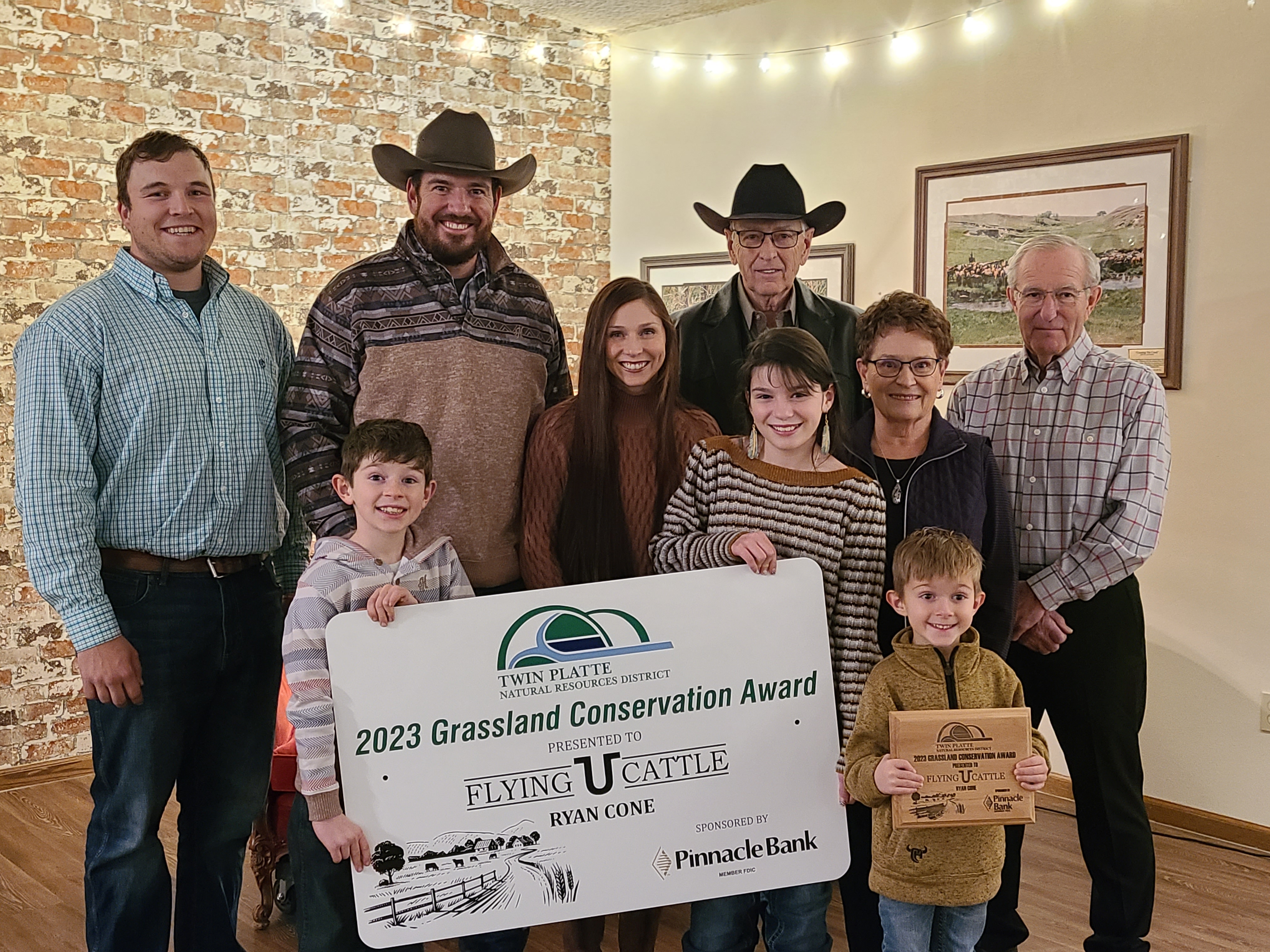
Flying U Cattle originated in 1989 by Robert (Bob) and Lexie Cone. Bob grew up on his parents’ farm and yearling operation in Loup and Blaine Counties. They raised feed and bought yearlings to feed over the winter and run on grass over the summer. Lexie’s granddad Jim Wilson bought a relinquishment in what is now Arthur County in 1908, after moving to Nebraska from Tennessee. Lexie’s grandma, Theo Daisy Barnt Corfield, obtained a homestead in 1913 in Arthur County. Theo’s daughter Doris Corfield, and Jim Wilson’s son Charlie Wilson, got married in 1940 and continued ranching in southwest Arthur County, where Lexie was born and raised.
Bob and Lexie leased ground and then purchased their first ground in 1992 in Keith County, where their son Ryan was raised.
Ryan attended the University of Wyoming and obtained a degree in Rangeland Ecology and Watershed Management and a Minor in Soils. Without having a family operation large enough to sustain him coming home, he had to figure out how to start his own operation. In 2014 he sold his business and purchased his first piece of ranch ground in Arthur County. That fall, he added on by purchasing the neighbor’s ranch. In 2022 he purchased a ranch split between Arthur and Garden Counties, known as the Smith Ranch. He was then able to buy a section that had been out of the middle of the Smith Ranch for over 100 years, making it now a solid block of land.
Today Ryan and his wife Tracy along with their three kids Collins, Ridley, and Callan, operate their part of Flying U Cattle, now consisting of 27,000 acres plus ground they lease.
Working closely with NRCS and utilizing programs such as EQIP and CSP is one of the major reasons Flying U Cattle is a success. The individuals at the Ogallala and North Platte NRCS offices have been invaluable resources for information and ideas. With land being hard to come by, Ryan knew that every piece of ground he was able to acquire needed to be improved and have grass production maximized. Over two dozen new solar water sites have been added using EQIP, along with several miles of pipeline with tanks, and more is in the works for next season. Adequate water in most pastures has now allowed Flying U Cattle to change over to rotational grazing programs allowing pastures to be deferred. Changes in land management strategies resulted in almost immediate visual improvements to the land. Blowouts that had been expanding every year for several decades were almost completely covered by vegetation within a couple years. CSP has been an excellent tool to help with grass monitoring and grazing management. Both EQIP and CSP fall right in line with what Ryan is passionate about, which is improving range quality by utilizing new water sites for better distribution of cattle grazing, and using range monitoring to constantly improve the quality of rangeland by tracking grass species and production to make grazing management decisions. Since the start of using grass monitoring techniques and incorporating that data with grazing strategies, grass production has on average increased significantly on the ranch.
The goal of Flying U Cattle now is to continue to use all available resources, including those provided by the NRCS and Twin Platte NRD. Working with these offices to enhance the productivity of the land will help create a sustainable operation so that Ryan and Tracy’s children will have the opportunity to come home to the operation and carry-on Flying U Cattle for many generations in the future.
Star Ranch, 2019
Lincoln County
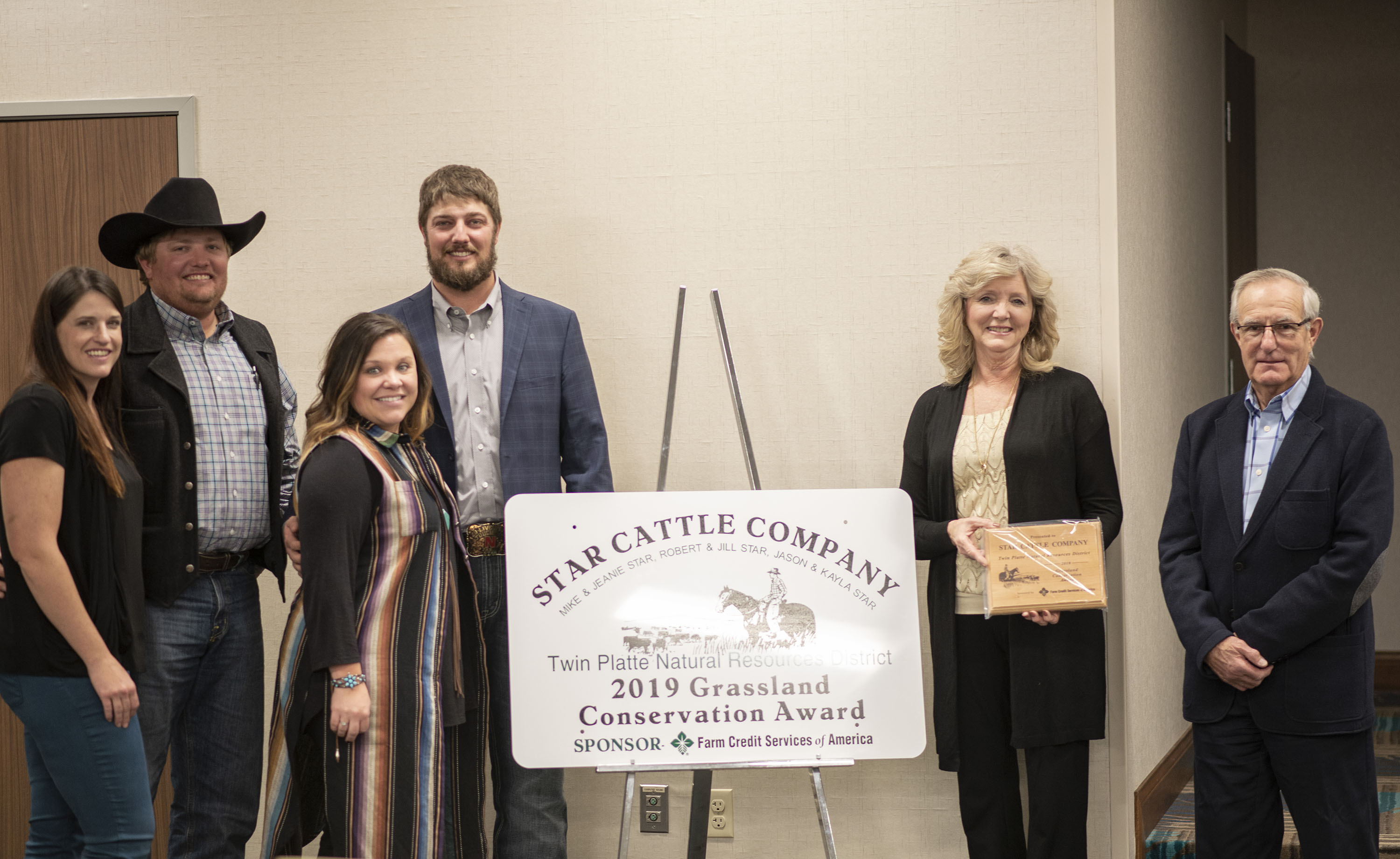
Star Cattle Company’s journey began back in 1912 when Fredrick A. Star purchased the home place on what is currently known as “North Star Road.” Fredrick Star immigrated from Germany to Ithaca, Nebraska. He married Hulda (Hanke) and they eventually settled further west here in Lincoln County. Their son, George Star Sr., married Sadie (Tetterton) from Dickens, Nebraska, opening the door to owning prime pasture lands in the Dickens area that were in her family. After coming home from college, Mike Star and his parents, George Star Jr. (aka Tiny) and Ann (Peterson), incorporated into Star Cattle Company on June 16th of 1981. Mike married Jeanie (Schumacher) in February of 1985, to which they had two sons, Robert (Jill) and Jason (Kayla), and a daughter, Jacqueline (Nick) Sass. Over the years the Star’s have been able to slowly expand their operation and diversify with fertile Platte Valley farmland and lush hay meadows. They have utilized the North Platte River accretion grounds and tree groves for calving cows and backgrounding calves. As a company they have also Invested in productive pastures as opportunities arose. One of the most beneficial and beautiful pastures has been the ground along the Birdwood Creek. Some of the early conservation practices are still evident in the tall Catalpa Trees that run along the road coming into the home place on North Star Road. Cedar Tree windbreaks were incorporated into the tall Cottonwood Trees at the North River Road Grove. These have proven to be very beneficial in protecting the cows and calves during the spring calving season. In the late 80’s and early 90’s, Mike consistently purchased new trees from the NRD offices for new wind breaks. As a young family, many Sunday afternoons were spent fencing, watering, and replanting, trying to ensure their existence. Deer, rodents, and weeds were a definite challenge, but he prevailed. Mike’s efforts are evident today with all the windbreaks in the sandhills north of the grove and along the Birdwood Creek. Range management was always a priority for the operation, never wanting to overgraze the highly utilized areas. The goal was always keeping the grasslands healthy for years to come. Working with the USDA-NRCS on EQIP projects allowed Star Cattle Company to implement rotational grazing on each of its ranges in the last six years. To help increase efficiency, water lines were dug, numerous tanks installed, additional wells drilled, as well as many fence lines adjusted as needed. This would not have been attainable in such a short time frame without their assistance.
Two Bar Two Ranch CO, 2018
Arthur County
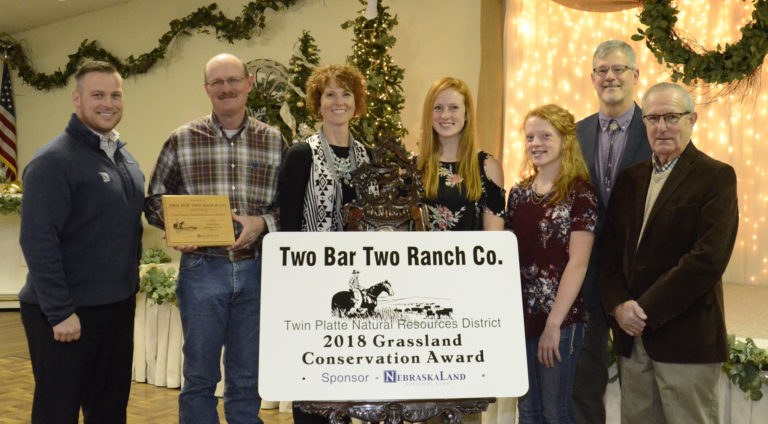
2018 Grassland Conservation Award was presented to the Two Bar Two Ranch Co. of Arthur County, Nebraska. The presentation was made at a December 13th award banquet held at the Haythorn Ranch Figure 4 Traditions Event Center. There to receive the award were Mark and Sandi Wilson and their daughters, Sheridan and Audrey. The family members received an award plaque and an outdoor sign which was sponsored by NebraskaLand National Bank of North Platte. Pictured from left, NebraskaLand Bank Vice President Hans Julius; Two Bar Two Ranch Co. representatives Mark, Sandi, Sheridan, and Audrey Wilson; Twin Platte NRD Grasslands Stewardship Coordinator Bill Carhart; and Twin Platte NRD Board Chairman Dennis Schilz (Photo by Jeff Headley).
Two Bar Two Ranch Co. was started by David Wilson in 1908. He moved from Tennessee to what is now Arthur County and homesteaded a section of land under the Kinkaid Act. David Wilson “proved up” and became owner of that land in 1913.
Over the years, the Wilson family has grown and added to the ranch. David’s son, Walter, and his grandson, Doug, put in a pivot and planted irrigated grass in 1979.They were one of the first in the Sandhills to use rotational grazing under a center pivot and found that yearling cattle were the most profitable in this rotation. They continued with various rotational grazing practices over the years.
More recently, the fourth generation on the ranch, Mark Wilson and brother, Michael Wilson, have used more rotational grazing and monitoring practices. With 300 acres of irrigated ground to work with, Mark started using 150 acres planted to rye as part of the grazing rotation. The rye plants provided excellent early-spring grazing while resting other pastures. This has improved the pasture rotation and given increased vigor to summer pastures.
Working with the USDA Natural Resources Conservation Service (NRCS) on Environmental Quality Incentive Program (EQIP) projects allowed the Two Bar Two Ranch to add wells, pipeline and tanks to pastures with limited water sources. New tank locations helped livestock better utilize available forage and also helped heal high traffic areas in pastures. The newer wells have been placed in corners of pastures and on higher hills, and are solar run. These deep wells are very economical and require very little maintenance.
Mark said, “The NRCS has helped give us the opportunity to be more efficient and productive than we ever thought possible. By increasing water supply and rotating pastures, we have increased grass and cattle production. Looking back, if we would not have been open to changing our practices, we would not have gotten to the point we are now.”
Mark and Sandi Wilson’s daughters, Sheridan and Audrey, have attended the Twin Platte Natural Resources District sponsored Adventure Camp about the Environment, and Youth Range Camp. They have been active in range judging and plant identification in FFA and 4-H. They also help with grassland monitoring at home. Sheridan was the overall Grand Champion at last year’s State Range Judging Contest, which had 536 contestants, as well as at the 5-State Old West Regional Contest. Mark and Sandi have encouraged the next generation to learn about grasslands by serving as 4-H leaders, including a 2018 trip with 4-H students to Washington, D.C. Mark has also served on the Arthur County Board of Commissioners for 18 years.
Waits Ranch, 2016
McPherson County
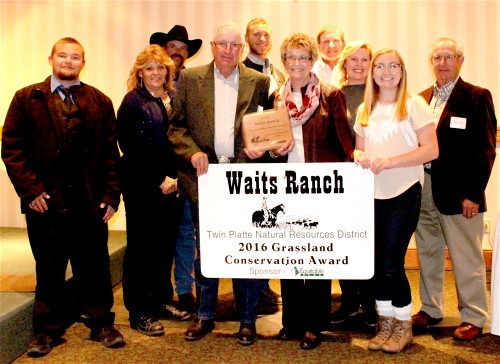
In 1972 Vernon and Pauline Waits purchased the ranch operation consisting of 1,280 acres from Vernon’s father, Lee Waits. After several years of leasing rangeland for their livestock operation, Vernon and Pauline purchased an additional 7,720 acres in 1990. In 1991, they began operation of their Uncle Francis Waits’ place which had been the original Waits and Wisner homestead. Following many years of improvements on the ranch, they now utilize 16,000 acres which complement their 1,000 cow/calf operation and the raising of 450 yearlings. With sons Steve and Mike Waits and other family members actively involved in the operation, the Waits Ranch is successful as they continue to use conservation practices on their grasslands.
There are several examples of conservation activities which have allowed the Waits Ranch to manage their grasslands well. They have installed multiple miles of cross fencing and developed numerous livestock water locations over approximately 30 years. That has allowed for improved grazing distribution within their pastures while improving grass cover and plant vigor. More recently, the Waits Ranch removed invading cedar trees that were spreading over newly acquired grasslands.
The Waits Ranch has participated in the Conservation Stewardship Program (CSP), the Environmental Quality Incentive Program (EQIP), and the Nebraska Soil and Water Conservation Program (NSWCP) in recent years. This has allowed them to receive cost-sharing and technical assistance from the USDA-NRCS (Natural Resources Conservation Service). The Waits Ranch has hosted tours to help share conservation information with others. The family has also participated in other rangeland education programs to expand their knowledge base.
The Waits Ranch has progressively moved toward rotational grazing strategies on all of their rangeland. They run their cattle in different age class herds, which generally rotate through a set of three to five pastures during the growing season. The number of days of grazing in each pasture varies according to the size of the pasture and number in the herd. This usually results in the grazing period being less than 45 days in a given pasture. That allows ample rest and recovery for the grasses. The Waits Ranch recognizes the importance of allowing rest for their pastures during the growing season to maintain good grass production, health, and vigor. They also have observed that their grazing program has prepared their grasslands to better withstand occurrences of drought, fire, grasshoppers, and hail. It is due to this commitment to the resources under their management that the Waits Ranch is receiving the 2016 Grassland Conservation Award from the Twin Platte Natural Resources District.
Eakins & Snyder / Snyder Bros, 2015
Keith County
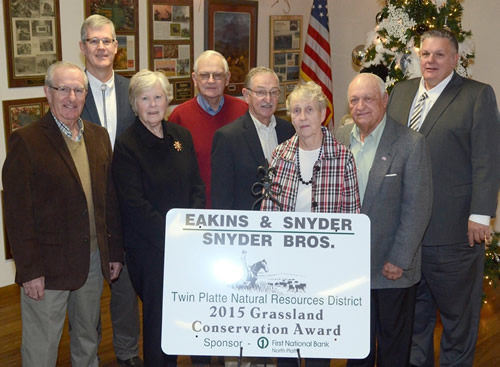
2015 Grassland Conservation Award Presented The Eakins & Snyder / Snyder Bros. operation from Paxton has been awarded the Twin Platte Natural Resources District 2015 Grassland Conservation Award. The presentation was made at a December 8th award banquet held at the Haythorn Ranch Figure 4 Traditions Event Center. There to receive the award were Bruce and Roxie Snyder, Ken Snyder, and Don and Karen Eakins. The family members received an award plaque and an outdoor sign which was sponsored by First National Bank of North Platte. (From left) Twin Platte Natural Resources District Board Chairman Dennis Schilz and Grasslands Stewardship Coordinator Bill Carhart, Roxie and Bruce Snyder, Ken Snyder, and Karen and Don Eakins, and First National Bank of North Platte President Greg Wilke. Not present for picture was Chris Snyder, Ken’s wife. (Jeff Headley photo)
The Snyder Brothers’ operation began over 60 years ago with a partnership between brothers Bruce and Bill Snyder. The original land holdings were owned in the 1920’s by the Chancellor of the University of Nebraska, the Dean of the University of Nebraska College of Agriculture, and Bruce and Bill’s father, William P. Snyder, the Superintendent of the University’s Experiment Station. It was these close ties with the University of Nebraska that led to the eventual use of new technology and implementation of proven breeding systems in the Snyder Brothers’ Angus breeding operation. Today, the cow herd still stems from the original 17 cows purchased in the 1940’s and is operated by the third generation of the Snyder Family, Bruce and Ken Snyder and their brother-in-law, Don Eakins.
Farming and ranching has been Bruce, Don and Ken’s only business. This dependence on agriculture led them to select genetics in their Angus herd that work well in the real world. Those economically driven traits included moderate mature cow size and moderate feed requirements, as well as calving ease. Their Nebraska Sandhills operation has provided over 1,000 bulls for their commercial and registered customer base during 60-plus years of operation.
Eakins & Snyder utilize irrigated forages including smooth brome under a side roll irrigation system, as well as rye planted in the Fall under several pivots. They also have corn stalks available as winter forage. For many years they have applied a planned grazing system to their upland pastures, having worked with USDA-NRCS staff over the years to get their system well established.
They have installed new fence and developed new water sources to improve livestock distribution. In recent years, they seeded nearly 200 acres to grass through USDA’s CREP Program and the Nebraska Buffer Strip Program, as well as an earlier 50 acre wheatgrass seeding. In 2012, Eakins & Snyder participated in a USFWS program to clear about 170 acres of invasive Russian olive and cedar trees from their river bottom grasslands. Also through that project about 3,400 linear feet of wetland slough was restored, along with invasive cattail removed from about five acres of wetlands.
The improved forage and habitat on their river bottom land is a prime example of what can be accomplished to enhance a grassland operation’s productivity. Congratulations to Bruce and Roxie Snyder, Ken and Chris Snyder, and Don and Karen Eakins on all your accomplishments!
Brosius RANCH, RObert & Jennifer BRosius, 2013
Lincoln County
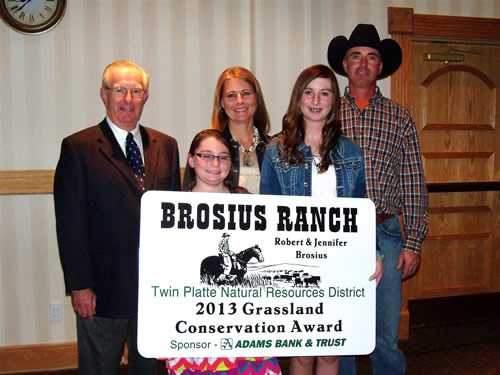
John Brosius was born in 1838 at Schleidweiler, Germany, where he was educated above the average. In 1883 Mr. Brosius came with his wife and children from Germany to Minnesota and then in early 1884 came to Logan County, Nebraska and took up homestead five miles south of Gandy on 159.89 acres. It was a time when there were no fences in the County.
From 1921 to 1965 land in the northeast corner of Lincoln County was gradually purchased to piece the ranch together. The Brosius ranch, now owned by William Brosius, John’s grandson, is currently comprised of approximately 4,500 contiguous acres.
The Brosius Ranch’s approach to land and resource management has changed over the years. In 2000 the ranch was leased from William and Donna Brosius to Jennifer and Robert Brosius, William’s nephew. At the same time the partnership that Robert was in with his father and brother was dissolved. As a result, Robert retained approximately 100 cows to run on the leased ranch. An additional 1,000 acres of rangeland owned by Robert and Jennifer and Robert’s father added to the grazing available. A portion of the ranch was sub-leased and yearlings were summer grazed. Grazing was set stocked and cows were calving in March. At that time Robert was running the cow herd, watching the take in yearlings and working as day help, while Jennifer was working as an Agricultural Loan Officer. Robert and Jennifer both have Bachelor degrees in Agri-Business from Chadron State College.
In 2004 the couple attended a Ranching For Profit workshop in Thedford, NE offered by the University of Nebraska Extension. They left the workshop with a hunger for additional information. Robert had been toying with some of the ideas presented and they both wanted to know more. A month later they attended the week long Ranching For Profit School. The school taught the couple about economics, finance, fundamentals for building a sustainable business, as well as ecology, range influences, principles of cell grazing, animal nutrition and reproduction. Some big decisions were made that week and neither regret the changes made, which has turned their ranch into a successful business while building on what Robert and Jennifer had already been thinking.
The Ranching for Profit School showed them how they could implement their ideas. The first major decision was to sell haying equipment. Although the ranch was not large, the cow numbers had tripled. The ranch has no meadows so any hay that had been put up in the past had been done on flat spots here and there. The Brosius’ determined that the cost of keeping the equipment was outweighed by the cost of purchasing necessary feed supplies. All the haying equipment was sold in February 2005. The next decision was to do some serious culling. The cows were weighed and frame scored at preg checking. Cows over 1,400 lbs and or a frame score over five were sold. Because it was too late to change the calving season, plans were made for the following year to turn out bulls July 23th for a May 1st start date.
The Brosius’ determined that because they leased a portion of their herd it would be necessary to have a written drought plan developed and agreed upon with the lessor. The drought plan lists critical dates and amount of moisture needed to continue as planned with the grazing year. If moisture were to fall below benchmarked levels at any of the four critical dates, a plan was written to easily identify what class of cattle and how many would be sold or go back to the lessor. Acknowledging that drought is inevitable was key in making the decisions in regard to the Drought Plan. Thanks to the written drought plan in place by 2012, the ranch has responded as planned and destocked forty percent of the herd.
Robert and Jennifer recognized that they were in the business to grow grass. The way the animals graze determines the health and productivity of both the animals and the range. They have spent considerable amount of time studying plant and animal health and production. In the spring of 2005 the Brosius’ started subdividing the section pastures into smaller paddocks. In addition, the Brosius’ have an irrigated pivot that had been seeded to grass and divided into paddocks in the spring of 2004 that became a part of the grazing cell and utilized more efficiently with daily moves.
At this time there are thirty paddocks on just over 4,000 acres of grass. The cow herd had grown to over 600 head before destocking for the drought, and replacement heifers are being retained. Cows graze cornstalks from November to the first of April. In April the cows start rotating through the ranch paddocks and start calving the first week of May. The Brosius’ drive about half of the cow herd to the KAR Ranch, Inc., north of Stapleton, to be summered there. The remainder of the herd is rotated throughout the ranch and the irrigated pasture is used as part of the rotation.
To enable cattle to run together, a great deal of livestock water pipeline has been installed and tanks have been set. The Brosius’ have taken advantage of the EQIP and Conservation Stewardship Program to make this possible. A tree reclamation was developed in 2012 and additional pipeline and cross fencing was put in place in 2013.
Other stewardship practices implemented have been: wild life ramps, supplement location rotation, irrigation pump evaluation, and annual monitored grazing. Unique grazing strategies used on the ranch include: strip grazing windrowed forage feed, and building a feed bank during the growing season.
Long-term sustainability is being built as the energy flow, water and mineral cycles, and biodiversity of the range improves with managed rotational grazing. The improved health of the land will continue to directly correlate with long-term sustainability and decreased operational costs. The premium is found in the increase in carrying capacity and animal performance.
Community involvement for the couple comes naturally. Both of their parents instilled service to others as an important part of their lives. They strive to be an example to their own children in the leadership and support roles they serve in. Robert is a Fair Board/Ag Society member. He coaches youth basketball, and has been a NSAA football official for twelve years. In 2011 his crew was selected to officiate the Class D2 State Championship game at Memorial Stadium in Lincoln, NE. Jennifer is a past Logan County 4-H Council President, she is Secretary of the St. John’s Altar Society, was involved in the development of the Stapleton website, is a PTA and 4-H leader/volunteer. Together they co-chair the Stapleton Jr. Rodeo, serve as lay ministers for their church, and sit on an Executive Link board for Ranching For Profit alumni. In 2011, when the Harvest Fires burned approximately 24,000 acres of their friends and neighbor’s land, they worked to raise over $25,000 to replace nearly 7,000 fence posts lost by the community’s farmers and ranchers. Other memberships include: NE Cattlemen, NE Beef Quality Assurance, and American Quarter Horse Association.
Jennifer currently works part time in the Human Resource department at Adams Bank and Trust in North Platte and is on the ranch the rest of the time. The Brosius’ daughters, Britney (13) and Hope (11) provide much of the “cowboy” help along with the Tony and Jane Haake family; Tristan (14), Gage (12), and Dayle (7). Outside day help is used as needed. The Brosius’ are firm believers in low-stress stockmanship and livestock handling using the Bud Williams model and techniques.
The Brosius Ranch mission statement is: Working with Mother Nature to build a sustainable business. Robert and Jennifer are proud to be fourth generation stewards of the Brosius Ranch. Although they don’t own the land they live and work on, they have made it their mission to use the knowledge and practices they have learned to increase the effectiveness of resource management and above all do what is right to ensure the sustainability of the land.
OTTER CREEK RAnch, 2012
Keith County

The Twin Platte Natural Resources District presented its 2012 Grassland Conservation Award at a banquet held the evening of Tuesday December 11 at the Haythorn Ranch Figure Four Traditions Event Center. The Otter Creek Ranch received the award, which was presented to Don and Joyce Tisdall – Owners and K.C. Peterson – Manager. The award consists of two plaques and an outdoor sign for the northwest Keith County ranch. The award was sponsored this year by Adams Bank and Trust, which was represented at the banquet by Bruce Luehrs.
The Otter Creek Ranch is named after the meandering stream that springs up in the Sandhills five miles north of Lake McConaughy. Otter Creek is one of very few streams in Nebraska capable of supporting trout populations that live in the cool, pure water that surfaces from the ground and flows over a gravel creek bed. Don and Joyce Tisdall purchased the ranch that included the headwaters of Otter Creek in January of 2000, as well as adjacent grassland property later on.
Don and ranch manager, K.C. Peterson, worked promptly to put in place improvements that enhanced their ability to manage grazing for years to come on the ranch, as well as improve the natural function of a rare watershed. Don and K.C. began working early on in the process with the Natural Resources Conservation Service staff at Ogallala, along with other grassland conservation professionals. They found that USDA’s Environmental Quality Incentives Program (EQIP) and a partnership through the Sandhills Task Force would help them meet ranch goals, which included developing a planned grazing system still in use today.
The new management approach in conjunction with improvements, such as additional livestock water sources, has allowed the ranch grasslands to improve. One project provided for fence installation on both sides of Otter Creek, which limited the time and season in which cattle were allowed to graze the stream banks. Prior to fencing out the stream, cattle would water there but not travel far to graze, leaving the stream bank subject to erosion as the grass close to the stream became depleted. This also left upland parts of the pasture under utilized since the cattle had little motivation to climb very far up the hills.
After the fence was installed, tall native vegetation grew back to protect the stream corridor as a buffer strip. The vegetation stabilized the stream banks and improved the water quality for fish and other wildlife, as well as for cattle that use the area on a limited, managed basis. At the time the stream was fenced, a new livestock water pipeline was in place to provide additional watering locations in pastures above the creek. The new water sources, as well as some cross fencing, allowed for better grazing management in the hilly creek pastures than ever before. Another part of the creek corridor project involved the removal of volunteer Cedar and Russian olive trees.
Their removal was a proactive effort to reduce the spread of those woody invaders and prevent them from taking over the grassland riparian area. Beyond the Otter Creek pastures, additional improvements have been made to enhance the ranch’s ability to successfully manage grasslands farther from the creek. Several thousand feet of livestock water pipeline and new watering locations helped improve grazing distribution over those pastures and aid in the ranch’s livestock management. The ranch was one of many affected by the wildfires in 2012, and grass cover was lost on the portion of the ranch that burned.
Grazing deferment is planned for the burned pastures as recovery will take some time due to the drought. However, the grassland management at the Otter Creek Ranch prior to these natural processes will help the pastures stay resilient and recover faster than if they had not been managed so well.
Broken box Ranch, Sundstrom Family, 2010
Lincoln County
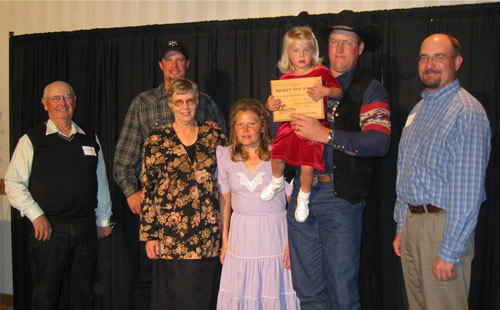
The Sundstrom family has owned and taken care of land in Lincoln County since the early 1900’s. Edward Sundstrom came to the United States from Sweden in 1904. In 1908, he married Christine Pearson in Dawson County. She also was born in Sweden and came to America seeking a better life. They settled on land between Brady and Moorefield and had three sons. Their youngest son, Chester, was born in 1913 and continued an interest in the land and raised cattle. Chester married Thelma Miller in 1940 and lived briefly in California when their son Larry was born. They soon moved back to the “good life” in Nebraska. Two more children, Kay and Raymond, joined the family. They lived many years in the hills between Brady and Moorefield. Larry married Donna Sommer in 1967 and they continued working with the land and livestock. Larry and Donna’s sons Rustin (Russ) and Neil are the 4th generation of Sundstroms to provide stewardship for the land. The boys credit their Dad and Grandpa for the strong conservation education they received from them growing up on the land.
The Sundstroms are constantly looking for ways to manage their livestock and grazing resources in a more efficient and profitable manner. They have utilized the facilitating practices of wells, pipelines, tanks, and cross fence to set up a grazing strategy that has improved the rangeland resource significantly in recent years. They also manage the timing of grazing, intensity, and periods of rest in their pastures to shift the plant species composition to a greater prominence of more productive grasses, such as big bluestem and sideoats grama. The Sundstroms have cleared the invasive eastern red cedar trees from all accessible grassland areas to increase the acres available for grazing, while at the same time improving wildlife habitat for mule deer and grassland birds.
The Sundstroms strive to maximize pounds of beef per acre while improving the rangeland resource. This is accomplished by improving forage harvest efficiency through their rotational grazing strategy, and by selecting genetics for their cow herd that are well suited to the rough hills of southeast Lincoln County. They have adjusted their calving dates to May-June to take advantage of green grass, reduce hay feeding expense, and minimize labor requirements during calving. The cows are viewed as income producers for the calves they produce, but also as tools to improve the soil, water, plant, and wildlife resources on the ranch.
All resources are effectively considered in a systems approach to manage the grasslands, labor, livestock, and economics of the operation. The Sundstroms believe in using what they have as effectively as possible. They observe that their sloping loess hills pastures catch more rainfall and have less runoff as they leave more grass height after grazing. They also realize that those grass plants have a better root system when cattle are not allowed to graze too much. Stronger roots better utilize soil moisture and provide more reserve strength for the grasses.
The Sundstroms use their cropland acres to grow supplemental forage sorghum and alfalfa. They also utilize corn stalks in the fall and winter. Russ and Neil Sundstrom own and operate a land clearing service in addition to ranching. They specialize in mechanical removal of invasive species such as cedar trees from the uplands in southeast Lincoln County.
They strive to maximize efficiency in this process while delivering a good result to their clients. Also through their land clearing business they find new ideas from other producers that can be tried out and sometimes fully implemented on the ranch if it works well for them. They often find there is an optimum that works better than the maximum. For example, they do not remove cedar trees in the steepest draws and they also recognize that male cedar trees can be left behind for wind protection with no risk of spreading small trees later. Russ and Neil have set a good example by clearing cedar trees from their most productive grazing acres.
The Sundstrom’s stewardship goes beyond the normal contracted service of general land clearing. They share with clients their experience in grazing management, noxious weed control, long term planning for future infestations, erosion prevention and protection, prescribed burning preparation, and various economic considerations. They have effectively worked with and promoted state and federal programs to assist landowners with cedar encroachment issues, as well as cross fencing and water placement opportunities. In 2009 the Sundstroms hosted a tour on their ranch that highlighted the grazing management and cedar control work they have accomplished with help from cooperating agencies.
Many people attended the tour, including fellow members of the Loess Canyon Rangeland Alliance, a landowner driven conservation group. These are just a few examples of how the Sundstrom’s stewardship and invasive species management efforts have extended well beyond the boundaries of their own ranch. Congratulations to the Sundstrom family for the recognition of their conservation and resource management efforts! They are well deserving of the Grassland Conservation Award from the Twin Platte Natural Resources District, with special thanks to Great Western Bank for sponsoring this year’s award!
Lute Homestead Ranch / Krab Ranch, 2009
Keith County
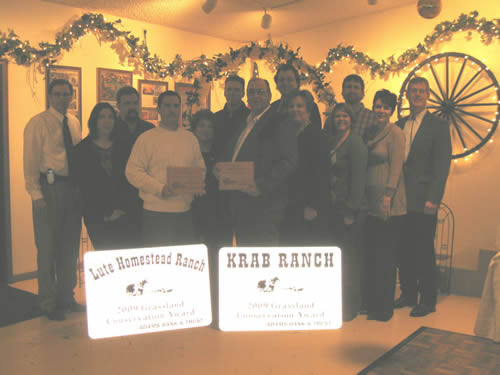
This year, the Lute Ranch of Keith County, Nebraska celebrates its’ 125th anniversary, and continues the family ranching tradition started by brothers Fred W. Lute and John Lute in 1884. The original homestead house located four miles east of Ogallala was built with limestone quarried from the hills located just north of the dwelling, and is still standing today. Fred W. Lute and his son, Fred H. Lute, expanded the operation to land in Arthur County, Nebraska, which continues in operation today. Fred H. Lute’s son, Robert F. Lute Sr. and his daughters, Rose Sara and Lula Lute, shared ownership of the ranch through the 1980’s.
After the death of Rose Sara and Lula, Robert Lute Sr. and his son, Robert F. Lute II, carried on the family business. Robert Lute II married Kathleen Lute in 1987, and got an “instant family” of sons Rick and Ken, and daughter Michelle. Robert Lute II was active in the Nebraska Stock Growers Association, and served as its president. Robert Lute II attributed the longevity and success of the ranches to conservative business policies and the underlying principles of good stewardship management practices. He was fond of saying, “If you don’t take care of the land, it can’t take care of you.” In 1992, Robert Lute II died unexpectedly, followed by Robert Lute Sr. in 1994.
The family tradition of success started 125 years ago is continuing with the current generation. The examples and lessons of the past still resonate with good stewardship practices carried on today. The Keith County Ranch, in partnership with the family of Mike and Chris Krab, continues to function with the understanding that we are only temporary stewards of the land, and the footprints we leave must be for the benefit of future generations to come.
The Lute Homestead Ranch has also benefited many local and state youth through hosting an Area Range Judging Contest in 2003, as well as the State Range Judging Contest in 2009 with 350 contestants in attendance! In 1994, the ranch began to pursue aggressive new range management tactics to insure the highest land utilization while maintaining ongoing conservation and stewardship practices. Working with the local USDA-NRCS office, the Lute Ranch and Krab Family began to develop innovative grazing and land management practices, which included the addition of new cross fencing, water development programs, rotational grazing strategies, and conservation protection areas.
An example of ranch innovation is on the steep breaks above the South Platte River where extensive cross fencing is impractical on those grasslands. Alternatively, more livestock water sources were developed by the Lute Ranch, which allows for better cattle distribution on the steep hillsides without much fencing. The Lute Ranch also utilizes hay meadows in a sustainable way. Instead of haying the whole meadow every year, Mike Krab discovered equal or better tonnage by haying half the meadow in strips on an every other year rotation. While maintaining the more productive grasses in a healthier condition, the strips also serve as good cover for young calves during calving season.
Mike also worked with NRCS staff to initiate a range monitoring program utilizing exclusion cages to measure actual forage yield per acre. A center pivot on the Lute Ranch also provides high quality forage in the form of alfalfa hay, as well as corn production where the corn stalks can be grazed. With the assistance of EQIP funding and plans developed in partnership with the NRCS, the Lute Ranch continues to expand operational and conservation strategies that will continue to benefit not only the business, but also improve and protect the quality of the natural resources on the ranch.
Both ranch families have appreciated and benefited from the technical assistance offered over the years by staff from the Ogallala NRCS Field Office. Future practices being planned include expanding the grazing rotation and livestock water development to expiring CRP land for the benefit of livestock and wildlife. Mike and Chris Krab have been in partnership with the Lute Family on their ranch between Ogallala and Paxton since 1998.
Mike and Chris are the parents of five children. Drew and daughters Emma and Jamie reside in Ogallala. Drew is Vice-President and commercial lender for Adams Bank and Trust in Ogallala. Nick lives in North Platte and is employed at Gerald Gentleman Station in Sutherland in the Operations Department. Tim, wife Lindsey, and their son Wiley live in Ogallala. Tim is employed by NPPD as a Civil Maintenance Technician. Tim also works part time on the ranch. Lindsey is employed as a payroll clerk for Keith County. Jen and husband Todd Winder, along with sons Carson and Logan, reside in North Platte. Jen is employed by Wells Fargo Bank in North Platte as an Ag lender, and Todd is employed as a claim representative at the Social Security Administration. Jill and husband Curt Richmond live in Grant. Jill is employed as a 4th grade teacher at Ogallala Public Schools. Curt is employed at Richmond Farms in Grant. All of the children and grandchildren have contributed throughout the years on the ranch. Mike and Chris are members at St. Patrick’s Catholic Church of Paxton. Mike is a member of the Knights of Columbus and the Ogallala Elks. He is a past member of St. Patrick’s Church council and Paxton school board. Chris is a member of St. Patrick’s Altar Society, where she served as president. She also is a member of the Paxton Legion Auxiliary and member of Paxton Booster Club, serving as past president.
Edna Peterson, 2007
Lincoln County
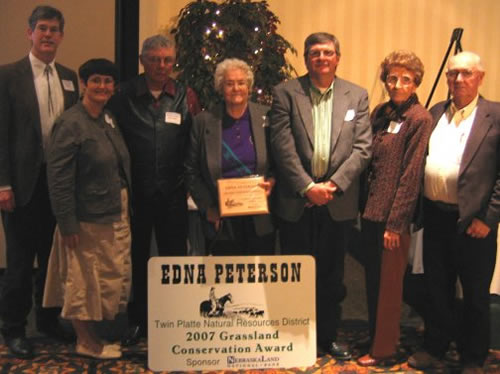
Edna Peterson was preparing for life on the ranch at an early age, having ridden a horse to school three miles each way, including to high school at Farnam. After graduation she took a K-8 teaching position in Stapleton. She also taught at Eustis and at various rural schools. Edna and Lloyd met and were married on December 31, 1948. They had no children of their own, but took in numerous foster children over the years. Though challenging at times, raising foster children was rewarding for the Petersons, especially as Edna sees them succeed later on in life.
By the time they married, Lloyd had purchased three ¼ sections of land. Some of that was cropland where they raised alfalfa, corn and wheat. They also raised some hogs to help pay the bills. Early on, they had more cows than pasture so they rented nearby corn stalks and also rented pasture from north of Tryon to near Stockville. They also rented pasture in the Garfield Table area of Lincoln Co., and when the owner was ready to sell, he wanted Lloyd and Edna to have it.
So they bought that property and later added gradually to their grasslands by putting together several sections of land purchased north of Brady in the Sandhills. Edna noticed that the longer they had their land, the more they saw the value of grassland conservation. They made early improvements through the Nebraska Soil and Water Conservation Program. This took place through the NRD with technical assistance from the USDA – SCS and later, NRCS. This partnership allowed them in the mid 1980’s to add a new livestock well, 2.5 miles of water pipeline and six new water tanks to improve livestock distribution in the pastures, one of which had been three miles long before being cross fenced.
The formation of the smaller pastures, as well as their management adjustments that went along with them, helped achieve a higher range condition on their operation with the assistance of USDA-NRCS and NRD conservationists. Lloyd passed away in the early 1990’s, but Edna was determined to keep their ranch going. With the encouragement of kindly neighbors and hired help, she not only maintained the ranching operation but enhanced it with a continuing conservation effort. This included several projects through the Natural Resources District and USDA-Natural Resources Conservation Service. These projects included the addition of five new livestock wells from 1994 to 2006. Also during that time, about 3,500 feet of water pipeline was installed to supply four new stock tanks.
The creative design of the newest watering system makes the most of a single well pumping to a high point where two enclosed supply tanks are located. These tanks then gravity feed to the stock tanks in several pastures located at various distances. The pasture in use at any given time has a reserve for when the wind does not run the windmill. A current EQIP agreement with USDA is continuing to improve the grazing resource with more watering locations for the livestock. The grazing rotation gives pastures needed rest from grazing so they recover and remain healthy.
Impressive are the quality and variety of grasses in the pastures of Edna Peterson. It shows that she has an understanding of the balance needed between current and future production. This long view of resource management is key to sustaining one’s ranching operation for years to come. It is about resisting the temptation for short term over-use to maintain long term productivity and grassland health, which is the foundation of a good ranch. For this reason, Edna Peterson is being recognized for her grassland conservation and management efforts.
Lute Ranches, 2006
Arthur County
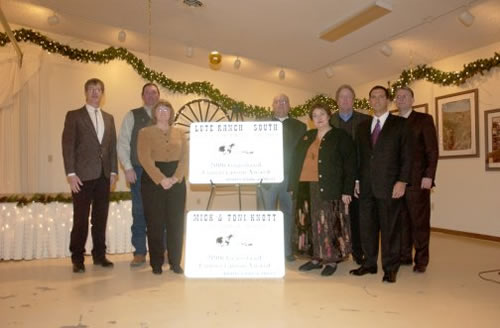
In 1884, the Lute Ranches started with the original Homestead Ranch in Keith County along the banks of the South Platte River and beside the Westward Trails. In 1920, the Lute Family began the acquisition of what would eventually become The Lute Ranches of Arthur County. After the death of Robert F. Lute II in 1992, Robert’s widow, Kathy Lute established the Robert F. Lute II Trust to carry on and preserve the legacy of the Lute Family ranching tradition. The goals of the Robert F. Lute II Trust are to preserve and improve the ranching operation, while protecting and conserving the natural resources of this fragile ecosystem.
This pragmatic ambition is being accomplished with the collective talents of the Trustees and its partners, Mick & Toni Knott, as well as personnel from USDA-NRCS / FSA and the Twin Platte Natural Resources District. The current Trustees of the Robert F. Lute II Trust are Kathy Lute, Gene Krab, and Kevin O’Donnell, with Rick Bourque serving as Resource and Facility Manager. In 1994, the Trust established their partnership with Mick & Toni Knott, who brought with them a wealth of experience from their prior work in the Sandhills. Mick and Toni’s conservation ethic and work ethic is a good fit for the overall ranch plan.
The Knott’s became valuable partners to the Trustees, as they planned together to enhance the ranch’s grasslands even more than had been accomplished in earlier years. Furthermore, the Knott’s were willing to implement the management changes in livestock rotation necessary to make the best use of the ranch improvements. The Knott’s and the Lute Trustee’s experience has shown them that rotational grazing systems are very effective in the Sandhills. Compared to season-long grazing, the rotational grazing systems help achieve better range condition and a stronger forage base for the operation, while reducing soil erosion and improving wildlife habitat and biodiversity. This shift in management required a commitment to increase water sources and cross fencing.
Natural Resources Conservation Service staff worked closely with Mick & Toni Knott, as well as the Trustees, to implement these changes virtually every year since 1995. The Federal EQIP program has provided cost-share incentives to help phase in these ambitious ranch improvements. Also, the Nebraska Soil and Water Conservation Program and the former Great Plains program were involved. Improvements made over the last 11 years include: 11 new livestock water wells; 17 new stock tanks; 21,400 ft of livestock water pipeline; 14,300 ft of permanent electric fence; and 22,900 ft of barbed wire cross fence The management decisions that went along with the ranch improvements worked hand in hand to produce a healthier plant community that better utilizes the limited moisture that falls during drought years.
The reserve forage at the end of a growing season helps improve plant vigor through maintaining a healthier root system. This allows the plants to come back stronger in the Spring, while providing more access to the soil moisture. Changes from the traditional use of certain pastures have improved their range condition. Positive outcomes include restoring over 300 acres of old blowouts, which is comparable to acquiring a new half section of land. As the old blowout areas continue to improve in range condition, they will produce more forage for years to come.
The animal impact in a rotational grazing system actually helps stabilize the old blowouts when the livestock presence is limited to a small portion of the growing season. As rotational grazing systems help prevent overgrazing near water sources, the cattle are also encouraged in smaller pastures to better utilize grass further away from the water sources. This improved livestock distribution helps keep desirable grass plants from being grazed repeatedly during the same growing season, which would have weakened those plants.
Another observation is that pheasant, grouse and deer populations are increasing with the improved grass production, along with the rows of shrubs and trees planted to provide food sources and shelter for wildlife, as well as wind protection for livestock. As the implementation and establishment of the practices took place, another positive outcome was the improved labor efficiency of running larger herds through the rotation. Then even as a conservative increase in stocking rate occurred on the ranch with these practices, the operation has still been able to maintain their full cow herd during the recent drought.
Similar range improvements are being made on the other Lute Ranch unit in Arthur County, which the Knott’s also work on with the Trust. Besides their work on the ranch, Mick and Toni Knott also enjoy their family which includes three daughters. Sami and Jeff Guest ranch near Crawford with their three children Megan, Sariah and Tyler. Jennie and Dan Dyer live at Sutherland, where Jennie is a Physical Therapist at Mid-Nebraska Physical Therapy in North Platte, while Dan teaches math and coaches at Sutherland High School. Jessie is at home in Arthur County.
Clarence & Lila Arensdorf, 2004
Lincoln County
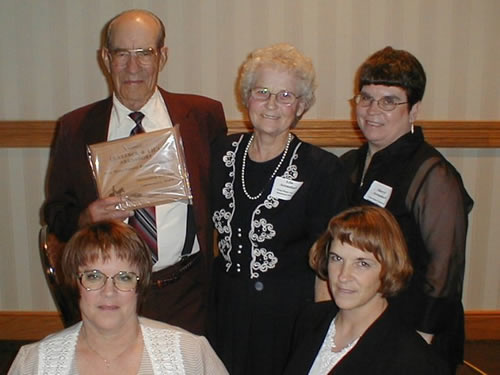
Clarence & Lila Arensdorf of Sutherland, are being recognized for a long-standing commitment to conserve and enhance the grasslands of southwestern McPherson County. Clarence has lived and worked there his entire life on land that has been in the family since 1919, when Clarence’s Dad, N.G. (Nick) Arensdorf, bought the property. Clarence and Lila were married in 1949, and they have been taking care of the place ever since. In 1953, they bought out the family’s land and cattle.
In 1967, they added the purchase of an adjoining section of land. The land that Clarence and Lila own includes some good, loamy soil that was suitable for dryland farming over the years. Using conservation practices such as strip cropping and crop rotations, they were able to raise alfalfa, rye, corn, and oats. At one point, over 100 acres of alfalfa was grown there. This diversity enabled their operation to be quite self-sufficient. For these efforts, the Arensdorfs also received the Twin Platte Natural Resources District’s Conservation Picture Award in 1988. Over the years, most of the cropland has been gradually seeded back to stands of native grasses.
The planted warm-season grasses represent species already found in adjacent pastures. These plants are deep rooted when good management follows their establishment, which allows them to continue being productive even in years when moisture is lacking on the surface. A lister planter provided the earliest re-introductions of grass seed back in the 1930’s. Then in 1986, 73 acres of the Arensdorfs cropland was seeded to grass through the Conservation Reserve Program. In 1993, another 30 acres of cropland were seeded to grass without any program assistance, as well as another 67 acres that recently began converting back to grass.
Currently, 40 additional acres are being seeded to grass through USDA’s Environmental Quality Incentives Program (EQIP). Only about 60 acres of cropland will remain on Arensdorfs upon completion of the 2004 grass seeding.
Krab INC, 2003
Keith County
Mads and Kirsten (Norgaard) Krab came to the Paxton area in 1891 after arriving from Wahoo, Nebraska, and having previously sailed from Denmark in 1880. The home site consisted of a quarter section of leased school land and they lived in a sod house until 1912 with two sons and six daughters. Their son, Martin, and Lucille (Hagge) Krab were married in 1928 and continued the operation by purchasing a section of grassland in 1940. Their son, Gene, and Jeanne (Perlinger) Krab were married in 1953. When Gene returned in 1955 after serving four years in the Air Force as S/Sgt, they continued operating the land near Paxton and in 1973 incorporated to form Krab Inc. with the help of their family. Their children include: Rhonda & Mike Bailey of Lincoln; Mike & Chris (Buss) Krab of Ogallala; Rod Krab of Paxton; Steve & Tweety (Kramer) Krab of Paxton; and LuAnn & Jeff Kluch of Papillion. Gene works with Rod and Steve as the main operators for Krab Inc. Their operation also relies on the help of the Rollie Albro family, Brad Bown, and Gene’s grandchildren, the Bryan Krab family and Martin Krab, who is presently serving in the U.S. Army.
Summertime finds the Krab’s livestock being rotated through owned and leased pastures in the sandhills north of Paxton. The livestock are then wintered south of Paxton on cornstalks. The other enterprises of Krab Inc. include irrigated and dryland corn, dryland wheat, alfalfa, hay meadows, and a feed yard. All of the corn and alfalfa raised by Krab Inc. is utilized by their cow herd in the feed yard, essentially adding value to those crop resources. The manure is utilized as fertilizer on the meadows and the farm ground. Soil samples are taken every year on all irrigated ground and every third year on meadows and dryland.
Krab Inc. generally manages their sandhills grassland with a two-pasture rotational grazing system. One pasture is used in the early spring and late summer, while the other is used during the warm season. The following year the usage is reversed in each pasture to help maintain plant diversity and vigor.
The Krab’s have added new wells and tanks so that there are currently 35 windmills, several electric wells, and two miles of running creek to provide water in their pastures. They recognize how the added water resources allow for improved cattle distribution in their sandhills pastures and make the grazing system more sustainable. They have also installed cross fences so that no one pasture is larger than a section in size, with some pastures reduced to a half section. The reduced pasture size allows for better herd management, including better record keeping on the cows and bulls.
Krab Inc. has done an excellent job of utilizing the new fence and water improvements they have installed to enhance the key process of grazing management. They have a long-standing practice of leaving residual grass at the end of the growing season to help ensure future production. Proper stocking rates and decisions on when to move the cattle are the result of their careful monitoring of the grassland resource. Their trend toward good to excellent range conditions indicates that they have a vigorous plant community that can tolerate drought better than before. They have also made timely adjustments due to the recent dry spell, such as early weaning of the calves. Their overall herd size continues to grow despite the dry weather, which is a credit to their good management.
The Krab’s have also managed to heal disturbed areas such as blowouts and old prairie dog towns. This has greatly reduced or eliminated the effects of wind erosion on these areas. In the blowouts, they accomplished this by shaping the steep edges and feeding hay on the areas of open sand. Then they followed up by changing the season of use from summer grazing to dormant season grazing. Now healed, those pasture areas are paying back productive dividends in their growing season grazing rotations. Krab Inc. has utilized the technical assistance provided by USDA-NRCS and the Twin Platte Natural Resources District during several of their projects. The CRP program helped return some of their cropland back to grass. The NSWCP and EQIP programs have also helped in the development of new water sources and fencing. The Krab’s have also planted tree windbreaks to offer livestock and wildlife protection.
There are other projects planned for the near future as they continue to look for ways to improve their land. They have hosted tours to share this vision with others. Members of the Krab family have also regularly attended range tours at other locations to look for new ideas and continue to grow. Krab Inc.’s goal is to be good stewards of the land by keeping the natural resources better than they found them for future generations. They appear to be right on course.
Fear Ranch Co, 2001
Lincoln County
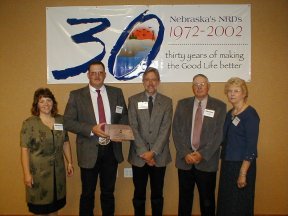
The Fear Ranch Co. is a good example of how commitment to land stewardship contributes to the stability and longevity of a ranch. Landan and Larren Fear have the privilege of being the sixth generation to live on the Fear Ranch. Their dad, Larry, is currently taking care of the land and cattle on the cow-calf-yearling operation, located about halfway between Sutherland and Wallace, Hershey, and Dickens. Bob Fear, Larry’s father, recently moved to town after his long career managing the place. The ranch currently consists of 16,700 owned and leased contiguous acres, which has been added to mostly a section or two at a time. At one time, both of Larry’s paternal great-great grandparents lived on what has now been acquired by the ranch.
Looking for ways to grow more grass has been a goal of the family for many years. Some attempts to do this in the name of conservation have been met with less than spectacular success, but valuable lessons were learned along the way. After World War 1 and again after the drought of the 1930’s, planting grass in newly acquired land did not work out well. It was later determined that the grass seed was not well adapted to this area. However, the Fear Ranch did experience success with grass plantings in the 1940’s and 1950’s.
Other priorities in those earlier years were fencing blowouts, mulching sandy spots, range interseedings, mowing only every other year, cross fencing, and adding more water sources. Back then, the Fear’s also practiced alternating pasture usage, where a pasture was used as summer pasture and then the next year only as winter pasture. Allowing the pasture a complete growing season of rest provided winter forage and boosted the vigor of the grass for the following years production. For a time, the Fear’s experimented with a high density, short duration grazing system; though now a more conservative rotational grazing system is in place. When center pivots came to the south hills in the 1970’s, the Fear’s rented an adjoining 2,800 acres of cornstalks for winter grazing. With the guidance of the University of Nebraska Extension Service, they added a 280 acre pivot of their own in 1973, when they raised alfalfa and cool season grass for hay and grazing. This has allowed the Fear Ranch to generally avoid buying outside protein, utilizing their home raised grass and alfalfa.
The current grazing program involves moving livestock through the pastures twice during the growing season. The first time through is for a short period in the spring with cool season grasses, and then again later in the season. Careful planning assures the livestock are not in the same pasture at the same time in consecutive years, a practice that maintains good plant diversity and vigor. Certain pastures acquired by the family have seen a dramatic improvement in range condition within just a few years of their management practices. A “photo plot” approach is currently being used to monitor the changes in the plant community as a result of the the grassland management. The Fear’s expect their present grazing scheme will continue to go through changes in the future, just as it has in the past.
Some of the more recent ranch improvements include installation of seven different pipelines, from one mile to more than six miles in length, so that every pasture has a dependable source of water for good grazing distribution. Cross fencing has also been a priority for many years. The largest pastures are one section in size, with many being reduced to a half section. As a testimony to the stability of the ranch, only once in the last 65 years has there been any outside females added to the cow herd. This trait carries through to the feedlot, where the same family has fed them for the past 31 years. By now, the cows and weaned calves have adapted to the Fear’s philosophy that the cattle will do most of the work. Their livestock often graze at least 11 months out of the year.
Over the years, the Fear’s initiated many of the range improvement practices that have been implemented. However, they have also utilized several programs for cost-share and valuable technical assistance through the USDA Natural Resources Conservation Service and the Twin Platte Natural Resources District. These include the former Agricultural Conservation Program and Great Plains Program, as well as the current Nebraska Soil and Water Conservation Program (NSWCP) and Environmental Quality Incentives Program (EQIP), which are in place to assist producers in carrying out important conservation practices on private land.
The Fear’s have recognized that the bottom line in ranching is keeping the operation economically viable. They are always looking for ways to improve the ranch and the lives of family members who depend on the property. Though economics is the primary reason for implementing the conservation practices, they have also achieved other benefits. For example, they have noticed more wildlife species on the ranch, including grouse, prairie chicken, turkey, and deer. Some of this can be attributed to the livestock windbreaks they have planted over the years, many with the benefit of a drip system.
A 1977 front page article and picture in the New York Times covering how the ranch was coping with drought brought interest from several foreign visitors, and prompted a write up in the Encyclopedia Britannica. Through the years, other groups have been welcomed to the ranch to gain knowledge from what the Fear’s have learned. The essence of their experience is to keep the natural resources healthy and productive for current and future generations. Applying this conservation ethic to their daily ranch decisions has served the Fear Ranch well over many decades, and is the reason why they are the 2001 Twin Platte Natural Resources District Conservation Award winner.
Korty Land & Cattle, 2000
Keith County
Marcellus and Phyllis Schulz began in 1944 what would become Korty Land & Cattle with 563 acres of land, 10 milk cows, 100 baby chickens, and a bank loan to purchase feed, equipment, and 30 head of steers. The cattle were fed with a small wagon and a scoop shovel in those days. Marcellus competently guided those early years of the operation with the help of his wife and their four children; Sharon, Calvin, Dennis, and Marcia. With the additional help of dedicated employees, this family enterprise has grown into the present farming, ranching, cattle feeding, and land improvement business that it is, which provides a good living for many families while conserving natural resources.
In the early 1950’s, Marcellus started building a cow herd with 50 Angus cows and two bulls. Their summer pasture then consisted of a half section of grassland, one windmill, and one large bottomless tank. In 1963, Marcellus and Phyllis organized the small family operation into a corporation named after the Union Pacific Railroad town of “Korty”, which was across the road from where they lived. Calvin returned from college in 1969 and Dennis in 1971 to rejoin the operation. In 1973, Bill Finch began working for the Schulz family, who were his neighbors. The Schulz brothers formed a partnership for their farming operation in 1977, and then Bill and Vina Finch joined the farming operation in 1994, which created the company “Schulz-Finch”. “Korty Land Improvement” began in 1983 with a dump truck, scraper, loader, dozer, backhoe, and two employees, and has grown since then. Marcellus contributed his abilities to the family business until his death in 1987.
In 1984, Korty Land & Cattle implemented a high intensity, short duration grazing system. Having plenty of fresh water is essential for such a grazing rotation to be successful. To accomplish this, 12 new livestock water wells were drilled and electric submersible pumps were installed. Portable generators were used where electrical lines were not economically feasible for such a well. A total of 7,733 feet of underground 2-inch water pipeline was installed and is maintained either by gravity or by a pressure system. Eighteen new livestock water tanks have been added, which provide two and sometimes three water sources in each pasture. The multiple water sources have given Korty Land & Cattle the ability to achieve better livestock distribution, especially on their more hilly pastures.
Korty’s have added 35,774 feet of standard and electric fence to divide their rangeland into smaller, more manageable pastures. Most of the division fence installed is more cost-effective electric fence material. As with additional water sources, this fencing effort has allowed for more uniform grazing of the pastures. Cattle are forced to graze virtually all the plants and not just the most desirable ones. This contributes to better range condition by improving plant vigor of desirable plants, which can then better compete with less desirable plants. Another improvement by Korty’s is the planting of appropriate grasses on irrigated sites. The amount of available forage has almost doubled due to the lasting benefits of the grassland improvements made over the years. As a result, the cow herd has now grown to more than 700 head.
In addition to the important grassland management practices for which they are being recognized, Korty’s have been instrumental in building 35 dams to control the damaging effects of runoff on their land and adjacent lands. They also began planting what now has become 35,000 trees and shrubs for livestock windbreaks and wildlife habitat on their land and neighbor’s land. Their investment in drip systems and weed barrier has helped those plantings reach their useful size more quickly. As they interact with and assist area producers, Korty Land & Cattle has been a tireless promoter of the importance of effective grazing management, livestock windbreaks, and the need to control invasive weeds.
Korty Land & Cattle has been an active member of the Society for Range Management since 1974. Cal attended the week-long Nebraska Range Short Course in 1982 at Chadron State College. Since that time, Korty employees Lyle Foight, Doyle Duggan, and Kim Duggan have also taken the course. In 1987, Cal gave a presentation on “High Intensity, Short Duration Grazing” at the Nebraska SRM annual meeting in Kearney. He has also attended and served as host of several range management tours, including one at the Thalken Ranch this year. Korty’s and the Ogallala USDA Natural Resources Conservation Service staff assisted Darrell Thalken in setting up the grazing system at Thalken’s.
The transformation of their portion of the Keith County landscape has not only provided better forage for livestock, but also stabilized the watersheds to reduce erosion, improve water quality, and provide wildlife habitat. These important changes brought about by Korty Land & Cattle can be attributed to their commitment to proper grazing management, and their strong overall conservation ethic.
Don & Rosemary Johnson, 1998
Lincoln County
The Johnson Ranch originated in 1898 when Don’s grandfather, Chris Johnson Sr., homesteaded on the present headquarters of the Johnson Ranch. The ranch was expanded by Don’s parents, Chris Jr. and Katherine Johnson. Under the management of Don and Rosemary, the ranch has expanded further to its present size of 9,100 acres.
Through the years the Johnson’s have made land stewardship a priority. Their dedication to improving the grasslands in their care has allowed them to witness a dramatic improvement in range condition. Don says that it has been very rewarding to see more grass in their pastures as a result of conservation efforts on the ranch. The Johnson’s have initiated many conservation practices on their own. In addition, they have also accomplished conservation through participation in the former Agriculture Nebraska Soil and Water Conservation Program.
Grassland improvement practices on the Johnson Ranch include the following:
- 565 acres of native grass seeding
- 15 new livestock wells
- 20 large livestock water tanks
- 1,980 feet of livestock water pipeline
- 16,500 feet of cross pipeline
- Livestock windbreak plantings
- Grading, seeding, mulching, and fencing of blowout areas
- Volunteer cedar tree control
- Implementation of a planned grazing system
Along with managing the ranch, Don has worked for 20 years as a night shift carman with the Union Pacific Railroad, while Rosemary runs a home-based baking business, selling at Farmer’s Markets and boutiques, and also making special orders. Their children are Jordan, Justina, and Jason, who help on the ranch when they are not involved in camps, 4-H, church, and home-school activities.
Kelly Ranch, 1997
Lincoln County
The Kelly Ranch of Sutherland, Nebraska was named winner of the 1997 Twin Platte Natural Resources Districts Conservation Award. The Kelly Family has steadily made improvements to their ranch over the years, by being committed to the needs of natural resources in their care. They have initiated conservation practices on their own, and have also participated in the Agriculture Conservation Program and Nebraska Soil and Water Conservation Program. Not only have range conditions improved for livestock, but also wildlife has benefitted. The ranch is home to mule and whitetail deer, pheasants, quail, grouse, turkey, and a few antelope. The Kelly’s have fenced off their land from the North Platte River to keep cattle from the river to improve water quality and to prevent streambank erosion.
Over 11,000 trees have been planted for livestock protection and wildlife. The first windbreaks were planted in the late 1930’s. The tree planting tradition continues, with the addition of drip irrigation and water conservation mulch to increase survival. A windbreak renovation project was completed at the home ranch. The Kelly’s received the American Tree Farm Service Award in 1988.
Back to Awards Home Page